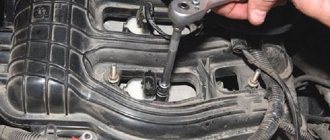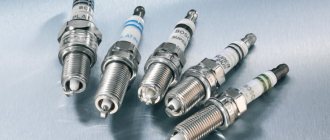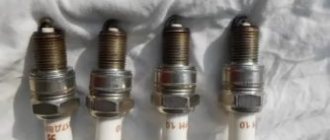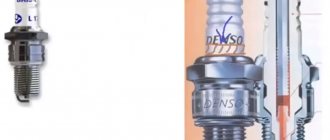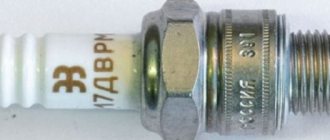Unlike diesel engines, the fuel mixture in the combustion chamber of a gasoline engine is ignited by an external source. This is a powerful electric discharge that jumps through the gap between the electrodes of the spark plugs. The latter are precisely designed to create a spark under conditions of high pressure and temperature characteristic of the gasoline combustion zone. The quality and rate of fuel combustion are influenced by many factors, including the distance between the spark electrodes.
Effect of gap on ignition
To understand how this factor affects the efficiency of a gasoline engine, you need to briefly consider the operation of the ignition system. The algorithm for converting fuel energy into mechanical work looks like this:
- Having released the exhaust gases through the valve into the cylinder head, the piston moves downwards. When it reaches the lowest point, the second valve opens, from where the air-fuel mixture enters the cylinder.
- The piston rises to the combustion chamber and compresses this aerosol several times.
- At the moment when the piston crown is at top dead center, a high-voltage pulse is applied to the spark plug electrodes. A spark jumps between them, igniting the compressed mixture of fuel and air.
- Burning at a certain speed, the fuel releases energy that pushes the piston down. Mechanical work is performed.
- The last stroke is the release of combustion products into the exhaust system, after which the cycle repeats.
A high voltage pulse (over 20 kilovolts) is generated by a coil based on a signal from the controller. Its winding is designed to generate a spark of a certain force, sufficient for high-quality ignition of a portion of the fuel mixture. If the gap in the spark plugs is too large or small, the combustion process will be disrupted.
Large gap between electrodes
A gap greater than 1.3 mm is considered abnormally large. What happens if the electrodes are extended to this extent:
- the coil power is not enough to spark an increased distance with each compression stroke, skipping cycles will appear;
- the operation of the power unit will be unstable and vibration will appear;
- one part of the unburnt gasoline will flow down the cylinder walls and enter the crankcase, the second will be thrown into the exhaust tract;
- fuel consumption will increase;
- Carbon deposits quickly form on the walls of the combustion chamber, the piston bottom and the working elements of the spark plugs.
Note. The higher the engine speed, the more misfires there will be, and the proportion of wasted gasoline will increase. The engine oil in the crankcase will begin to liquefy and release flammable vapors that enter the chamber through the breather pipe and air path.
As a result of the above processes, the engine will not deliver full power, and the cylinder-piston group will wear out faster in the long run. Too large a gap affects the quality of fuel combustion, you will feel this while driving: car acceleration will be sluggish, and engine vibration will be increased. Due to skipping cycles, problems with cold starting will appear - the engine will start after several attempts.
Interelectrode distance too small
A distance between spark plug contacts of less than 0.6 mm is considered unacceptably small. True, skipping work cycles will not be observed, but another problem will arise - too weak ignition. A short spark that breaks through a small gap from one electrode to another is not capable of properly igniting the air-fuel mixture, which occupies the entire volume of the chamber.
Due to the reduced burning rate, the air-gasoline aerosol will not have time to burn out entirely before the stroke of the piston begins, and then the exhaust gases are released. As a result, the consequences described above occur - a drop in the power of the power unit, increased fuel consumption, soot in the exhaust and carbon deposits inside the cylinders.
Incorrect adjustment of the spark plug gap is often aggravated by other factors: wear of the piston group, problems in the fuel supply system, broken insulation of high-voltage wires, and so on. Then the problem of adjusting the gaps recedes into the background and often falls out of sight of the car enthusiast.
Symptoms of replacement
The process of replacing spark plugs is quite simple and can be done independently.
According to the manufacturer's regulations, spark plugs must be replaced every 30,000 km . However, in the harsh Russian realities, not every detail is able to work out the time allotted to it.
The following signs indicate the need to replace spark plugs:
- The starter spins longer than it should when starting the engine.
- Gasoline consumption has increased.
- Extraneous sounds are heard from the engine during the warm-up process. Why does the engine take a long time to warm up?
- Reduced motor power . This is especially noticeable when trying to drive up a mountain.
- The spark plugs are "wet from gasoline".
That is, they are flooded. To check, you need to unscrew the spark plugs and inspect them. Too uneven carbon deposits on the electrodes of the spark plugs indicate problems in the operation of one or another cylinder.
Soot on spark plugs does not always indicate that they need to be changed. If the mileage is still low, then the consumables can be cleaned. For example, a gray-yellow or brown coating indicates that the electrodes are not very worn.
Normal clearance size
The permissible limits of the interelectrode distance are from 0.6 to 1.2 mm. A more precise value is selected depending on the type of engine, power supply and ignition system:
- old-type carburetor engines with a low compression ratio and a mechanical spark generation system - 0.6–0.7 mm;
- the same engines equipped with non-contact electronic ignition – 0.8–0.9 mm;
- in turbocharged and naturally aspirated power units with fuel supplied by injection (injector), the gap on the spark plugs should be from 1 to 1.2 mm.
Advice. The best way to correctly determine the interelectrode clearance for a particular vehicle is to carefully study the operating instructions. In the vast majority of cases, this value is indicated among other setting parameters.
Since the owners of many vehicles equipped with gasoline engines switch to liquefied gas, the size of the spark plug gap requires adjustment. For high-quality combustion of a mixture of propane and air, it is recommended to increase the ignition intensity by increasing the clearance by 0.1 mm from the rated value. The load on the high-voltage coil will increase slightly, and the gas will burn better.
Interelectrode gap for different spark plugs
Cars that use gas as fuel involve a different method of fuel combustion. Thus, propane has a high octane number and high combustion temperatures. As a result, the use of spark plugs with the lowest heat value is required when refueling with 92-grade gasoline.
In a situation where the car is designed for 95 gasoline, then when installing gas equipment, you can use spark plugs with the recommended gap. Thus, it will not be possible to simply bend the side contact onto the spark plugs for a gas-powered unit.
Owners of foreign cars are often interested in the question: what gap between the spark plug and the “precious” electrode is considered normal? Spark plugs with a central contact made using iridium, platinum or silver are considered to be of higher quality. The contact gap in these parts is large. And the use of such “precious” metals affects the resistance of the material to high temperatures. This is based on the fact that the resulting spark charge is more stable and does not depend on the gap between the electrodes.
The reluctance to measure the spark plug gap is due to the slowdown in replacing old elements. But if you carry out this procedure in a store or directly at the car, you can avoid many problems during engine operation. After all, contacts can be damaged during transportation and loading, which in the future will affect the appearance of defects in the operation of the car.
The presence of interference when the fuel mixture ignites is often associated with improper operation of the spark plug, namely the inaccurate distance between the electrodes.
What kind of gap are we talking about? Of course, about the gap between the spark plug electrodes. The spark plug is the “weak link” of a gasoline engine.
Is the engine difficult to start? Does it work intermittently? First of all, check the spark plugs. Carelessness can be costly! What happens if the engine is running with a faulty spark plug? Misfire occurs in the cylinder, unburned fuel flies out into the exhaust pipe, disabling the catalytic converter - a very expensive thing. In addition, fuel consumption increases and engine power decreases - your money goes down the drain.
Reliable sparking is the main requirement for spark plugs
What determines the sparking of a spark plug? Mainly - on the size of the electrodes and the size of the gap between them .
The theory states that: - the thinner the electrode, the higher the electric field strength; - the larger the gap, the higher the spark power.
There is a way out of this situation - the electrode is covered with a layer of refractory metal (platinum, iridium) . This technology makes it possible to reduce the diameter of the electrode to 0.4-0.6 mm. At the same time, the resource and cost of the candle increase sharply (several times!).
As everyone knows, spark plug gaps must be set in accordance with the engine manufacturer's recommendations. What happens if the gap is changed? It has been experimentally proven that “ordinary” spark plugs are sensitive to both a decrease and an increase in the gap - the intensity of the spark decreases, and the likelihood of misfire increases. The opposite is true with “thin-electrode” spark plugs - they practically do not react to changes in the gap, sparking remains powerful and stable.
During operation, the spark plug electrodes gradually burn out, thereby increasing the gap. This means that over time, the spark formation of a “regular” spark plug will worsen, but that of a “thin-electrode” spark plug will remain virtually unchanged!
In addition to the considered “geometric” parameters of the spark plug, the reliability of ignition is also influenced by external factors : - pressure and temperature in the cylinder; — composition of the combustible mixture; — combustion chamber shape; — in different engine operating modes, the operating conditions of the spark plug also change.
Hence the conclusion - the spark plug must match the engine!
How to choose spark plugs for a car
If you buy a spark plug recommended by the engine manufacturer, then no questions arise here. And if you need to choose an analogue? There are a great many offers on the spare parts market. How can you avoid making a mistake here?
First of all, take an interest in the glow number of the candle , which characterizes the degree of heating during operation. If the plug is too cold for your engine, it will not warm up to self-cleaning temperature and will quickly become covered in carbon deposits. If the spark plug is “hot,” it will overheat, which can cause glow ignition—self-ignition of the mixture from hot electrodes, and not from a spark.
Glow ignition is a very dangerous phenomenon for the engine and can even lead to engine failure. It is worth noting here that spark plugs with a thin central electrode are much less susceptible to the risk of glow ignition , and they are much better at self-cleaning.
Secondly, when choosing a spark plug, pay attention to the length of the protrusion of the heat cone, the length of the threaded part, the sealing method (cone or ring), the size of the hexagon for the spark plug wrench (see Fig. Spark plug design). All these dimensions must perfectly match the dimensions of the “original” spark plug of your car.
Setup recommendations
Checking and adjusting the gap on the spark plugs of the ignition system is carried out in the following situations:
- After repairing the engine, power supply and ignition systems, or before measuring compression in the cylinders. During operation, the spark plug electrodes gradually burn out and become thinner, causing the gap between them to increase.
- When replacing spark plugs with new ones. Often the manufacturer sets the gaps too small, which have to be increased to normal.
- When the engine became unstable. The first step is to unscrew the spark plugs, thoroughly clean the contacts, adjust the interelectrode distances and check their performance under pressure.
Cleaning the electrodes and pads from carbon deposits should always precede adjustment.
An important point to remember is that it is impossible to clearly set the gap on the spark plugs without a feeler gauge. Adjusting by eye will do as a temporary measure until you get to the garage with the tool.
- Remove the spark plugs from the engine cylinders and allow them to cool to room temperature. It is impossible to measure the size of the gaps “hot”.
- Clean the contacts with a wire brush and check the gap between the electrodes with a probe of the required thickness. The latter should fit tightly between the contacts, with little resistance.
- If the feeler gauge does not fit, increase the gap by bending the top electrode with a flat-head screwdriver. Too large a distance can be removed by gently tapping the contact.
It is easier to perform the operation on a cooled engine - you won’t have to burn your hands while unscrewing. For regular spark plugs, use a flat probe, and for products with 2-3-4 side electrodes, use a round tool. Install the spark plugs in the cylinders, start the engine and observe the idle speed. If the previously noticed vibration does not stop, the fault should be looked for elsewhere.
Owning a car means regularly replacing many parts. One of these parts are spark plugs, which are responsible for the timely ignition of the air-gasoline mixture. Their performance is assessed by analyzing the gap between the electrodes. It can vary depending on many factors. Therefore, if problems arise in the operation of the engine, the spark plugs are first checked. In this case, the gap between the electrodes is assessed. Then you can ask the question - what should be the gap on the spark plugs so that there are no problems in a running car.
When is it necessary to replace spark plugs?
The replacement of spark plugs is carried out no later than 40,000 km, since by this mileage the wear of the insulators on the spark plugs is already quite decent, and the temperature may increase the gap between the contacts, which will lead to incorrect operation of the spark plug.
You should also first replace the spark plugs if misfires are detected in the cylinders or unstable engine operation, interruptions in operation and loss of power.
The concept of electrode gap and its purpose
The spark plug has a pair of contacts. The first is the positive central electrode, and the second is the negative side electrode. The central contact is a link in the chain of supplying current from the ignition coil. The side element is shorted to ground. A spark appears between these elements during the movement of the pulse. Thus, its characteristics are directly dependent on the distance between these two electrodes.
Depending on the type of engine, fuel quality, and power, certain spark plugs should be selected. These spark plugs are recommended by car manufacturers. If you want to use such elements intended for one car on a vehicle of another brand, then this will not work. Since the gap between the contacts is an important quality of spark plugs.
The distance between the electrodes affects the following properties of the motor:
- Stability of operation;
- Developed power;
- Number of maximum revolutions;
- Fuel consumption;
- Duration of operation of many parts.
Therefore, it is worth periodically assessing the interelectrode distance. As a result, based on the mileage on the spark plugs used, judge whether to replace parts or the possibility of increasing (decreasing) the gap.
About candles
The spark plug in the engine is a very important element, without which the internal combustion engine simply will not work. At the moment the spark is applied, the fuel mixture in the combustion chamber is in a compressed position, when a spark appears, the mixture ignites and an explosion occurs, thereby pushing the piston down. The spark plug serves as a link between the ignition coil and the combustion chamber.
The difference between candles
Two types of engines with 8 and 16 valves were installed on the Lada Kalina. The type of spark plugs depends on the number of valves. The difference between the spark plugs in a 16-valve engine is the smaller diameter of the hexagon, since these spark plugs are placed in the spark plug well, where there is a rather narrow distance from the walls, which does not allow the use of spark plugs with a 21mm hexagon.
Spark plugs from a 16-valve engine can be installed on an 8-valve engine, but vice versa will not work, spark plugs from an 8-valve engine will not fit into the spark plug well.
Candle device
Reducing and increasing the gap
When the engine is running, spark plugs also perform their functions. Accordingly, it is possible for them to decrease or increase the interelectrode length. Different results are possible regarding the nature of the gap.
If the gap between the spark plug electrodes is reduced, the following consequences appear:
- The power of the spark increases, but it becomes short, which is reflected in the inability to influence the combustible mixture. As a result, a flood of spark plugs occurs, which affects such a phenomenon as “the car begins to stall.”
- The likelihood of an electric arc forming at high speeds increases. This is due to the fact that a spark obtained at a small electrode distance does not have time to explode. Therefore, there is a continuous flow, affecting the operation of the motor and coil, in which a short circuit may occur. Such moments entail the replacement of many parts.
The results of a small gap of electrode elements imply repair of the engine and its components.
What candles to put in Kalina
The manufacturer for Kalina recommends domestic spark plugs of type A17DVRM (for 8-valve engines) and AU15DVRM, AU17DVRM (for 16-valve engines), as well as their foreign analogues. For example, for 8-valve cars, spark plugs BRISK LR15YC (Czech Republic), BOSCH WR7DC (Germany), NGK BPR6ES (Japan) are suitable, for 16-valve cars, respectively, BRISK DR15YC, BOSCH FR7DCU and NGK BCPR6ES.
All of the above spark plugs are single-electrode – this is the type again recommended by the manufacturer. It is not prohibited to install multi-electrode analogues (it is believed that they give a better arc), just keep in mind that they will cost a little more, and you may not notice the effect. As for iridium and platinum spark plugs, their main advantage is their long service life.
Gap size
What is the spark plug gap based on vehicle type? The clearance between the contacts is different for different brands of cars. For cars currently produced, a certain spark plug gap is typical. Therefore, engine manufacturers do not recommend adjusting the distance yourself.
Regarding Russian-made cars produced in past years and today, the interelectrode length depends on the quality of the motor. If there is a carburetor type with a contact type of ignition, then the value corresponds to the interval of 0.5-0.6 mm. For contactless ignition, the indicator is reduced to 0.7-0.8 mm. In the situation of an injector, an intermediate length of 1.0-1.3 mm is maintained.
HOW TO REPLACE CANDLES FOR VAZ 2170, 2171, 2172 LADA PRIORA WITH YOUR OWN HANDS.
If you have everything, then you can proceed:
1. First, remove the decorative plastic casing.
2. Next, disconnect the ignition coil terminal.
3. Unscrew the coil mounting bolt.
4. Using a flathead screwdriver, remove the ignition coil.
5. The spark plug is located in a recess, in the so-called spark plug well, so to unscrew it you will need an extension cord.
6. Be careful, if you notice traces of oil in the spark plug well, be sure to find out its origin; the engine may need immediate replacement of the cylinder head gasket.
7. If this is your first time replacing spark plugs, then it will take some effort to unscrew the spark plugs; in some cases it is simply impossible to do this with a simple spark plug wrench. To do this, you will have to buy a special spark plug socket with a knob.
Interelectrode gap measurements
Considering what spark plug gap affects, you should think about the gauging process. For this, there are special probes, which can be purchased on the shelves of spare parts stores. These devices are classified into three categories:
- Plate-shaped;
- In the form of a wire;
- In the form of a coin.
The plate-shaped probe is similar to a knife. The existing plates on the surface of the device allow you to accurately measure the distance. Wire and coin-type devices have almost the same design in the shape of a circle. A wire device is characterized by the presence of loops of wire with different circumferences. They serve to measure the size of the gap. The coin-like stylus is equipped with a rim, the layer of which varies depending on the position. There is also a scale to indicate the size of the gap.
To determine the distance between the electrodes using a coin-shaped probe , you need to follow the diagram:
- Remove dirt and carbon deposits from the surface of the spark plug;
- Place the rim of the probe in the interelectrode space;
- Rotate the device until the contact connection period;
- Determine the size using the scale;
- To increase the clearance, it is necessary to bend the side contact using the rim;
- To compress, carefully bend the contact by applying pressure.
When using a wire probe, the distance corresponds to a suitable wire loop located in the interelectrode space. Loop thickness is a measure of the length between pins. The device has shaped plates to increase the gap.
The plate probe allows you to easily and simply measure the required value using plates of different thicknesses. They are placed in the space between the contacts. The spark plug gap is adjusted using the device itself.
If you cannot adjust the distance using the device, you can use pliers and a flat-head screwdriver. You can tap the pliers lightly to reduce the gap. If you need to bend the side element, this can be done with a flat-head screwdriver.
What kind of gap are we talking about? Of course, about the gap between the spark plug electrodes. The spark plug is the “weak link” of a gasoline engine. Is the engine difficult to start? Does it work intermittently? First of all, check the spark plugs. Carelessness can be costly!
Ceramic deposits have appeared - change the spark plugs immediately!
In terms of their operational parameters, including durability, all components of the listed items are almost the same from each other. This is confirmed by reviews from car owners expressed on various forums, etc. Perhaps there are more expensive components, the use of which will allow a simple replacement to increase power, engine torque or some other characteristics. But having installed such spark plugs in the 21126 engine, you will most likely have to forget about the warranty on the AY-K3 gearbox. It’s always like this with technology: we need to imagine what exactly we are doing and what we want to achieve as a result.



